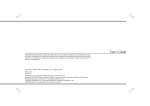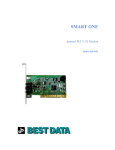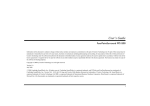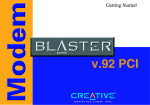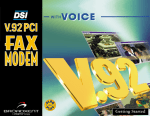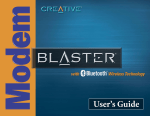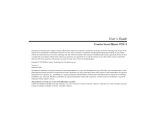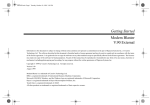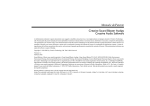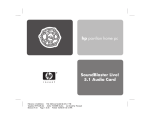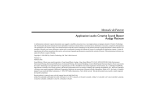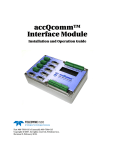Download Creative Blaster v.92 External Specifications
Transcript
v.92 External Copyright Information Modem Blaster V.92, External DE5621 Information in this document is subject to change without notice and does not represent a commitment on the part of Creative Technology Ltd. No part of this manual may be reproduced or transmitted in any form or by any means, electronic or mechanical, including photocopying and recording, for any purpose without the written permission of Creative Technology Ltd. The software described in this document is furnished under a license agreement and may be used or copied only in accordance with the terms of the license agreement. It is against the law to copy the software on any other medium except as specifically allowed in the license agreement. The licensee may make one copy of the software for backup purposes. Copyright © 1998-2001 by Creative Technology Ltd. All rights reserved. Version 1.0 September 2001 Sound Blaster and Blaster are registered trademarks, and the Sound Blaster Audigy logo, the Sound Blaster PCI logo, EAX, Creative Multi Speaker Surround, and Oozic are trademarks of Creative Technology Ltd. in the United States and/or other countries. E-Mu and SoundFont are registered trademarks of E-mu Systems, Inc.. SoundWorks is a registered trademark, and MicroWorks, PCWorks and FourPointSurround are trademarks of Cambridge SoundWorks, Inc.. Microsoft, MS-DOS, and Windows are registered trademarks of Microsoft Corporation. Manufactured under license from Dolby Laboratories. Dolby, AC-3, Pro Logic and the double-D symbol are trademarks of Dolby Laboratories. © 2001 Dolby Laboratories. All rights reserved. All other products are trademarks or registered trademarks of their respective owners. This product is covered by one or more of the following U.S. patents: 4,506,579; 4,699,038; 4,987,600; 5,013,105; 5,072,645; 5,111,727; 5,144,676; 5,170,369; 5,248,845; 5,298,671; 5,303,309; 5,317,104; 5,342,990; 5,430,244; 5,524,074; 5,698,803; 5,698,807; 5,748,747; 5,763,800; 5,790,837. Contents Introduction Before You Begin................................................................................................................... vii Recording Model and Serial Numbers ..................................................................... vii Checking System Requirements............................................................................... vii Document Conventions ............................................................................................ viii 1 Installing the Modem On Your Modem ................................................................................................................... 1-1 Setting up the Modem........................................................................................................... 1-2 Connecting Telephone Line and Phone Set......................................................................... 1-3 About Your Telephone Line....................................................................................................... 1-3 2 Installing Software Installing Drivers in Windows 95......................................................................................... 2-2 Installing Drivers in Windows 98/ME ................................................................................. 2-4 Installing Drivers in Windows NT 4.0 ................................................................................. 2-5 Installing Drivers in Windows 2000..................................................................................... 2-7 Testing the installation in Windows 95 ................................................................................ 2-9 Testing the installation in Windows 98/ME....................................................................... 2-10 Testing the installation in Windows 2000.......................................................................... 2-11 i Uninstalling Drivers in Windows 95.................................................................................. 2-12 Uninstalling Drivers in Windows 98/ME .......................................................................... 2-12 Uninstalling Drivers in Windows NT 4.0 .......................................................................... 2-13 Uninstalling Drivers in Windows 2000.............................................................................. 2-13 Installing NetWaiting .......................................................................................................... 2-13 A General Specifications B Troubleshooting Problems Encountered..........................................................................................................B-1 Problems Encountered in Windows NT4.0.............................................................B-3 Resolving Hardware Conflicts .............................................................................................B-4 In Windows 95/98.....................................................................................................B-4 General Q&A ........................................................................................................................B-4 ii Introduction Welcome to Modem Blaster! World. Your new modem allows you to fax documents, transfer data and access online information easily from your computer. Some of the features of your Modem Blaster are: Plug and Play This feature allows you to install your Modem Blaster easily, as the device is automatically configured. Send and Receive faxes You can use your Modem Blaster to send and receive fax documents. You can also configure the modem to serve as a fax-on-demand system by using the software provided. Internet Access Modem Blaster allows you to access computer bulletin boards and to browse the Internet at speeds of up to 56 Kbps. Introduction iv Answering Machine Modem Blaster functions as an answering machine with multiple mail boxes. Remote users can leave messages in your mail box, and you can play back these messages at any time. Modem Blaster even pages you to notify you of new messages! Caller ID Modem Blaster displays phone numbers of calling parties if your phone is Caller-ID enabled. Video Conferencing Your Modem Blaster comes complete with V.92 standard support, for use with H.32x video conferencing systems. Quick Connect This feature drastically reduces the amount of time it takes for your Modem Blaster to establish a connection with your Internet Service Provider. Line conditions of the last number called are saved in your computer and retrieved to reduce connection time. Introduction v Modem On Hold This feature allows you to answer an incoming call by placing your Modem Blaster on hold. Check with your local Internet Service Provider on whether this feature is supported in your area. PCM-Upstream This feature enhances your Modem Blaster’s data upload speed from 33.6 Kbps to a maximum of 48 Kbps. V.44 Data Compression Your Modem Blaster incorporates the new V.92 standard. This new standard offers V.44 Data Compression technology that allows you to browse the Internet at higher speeds than existing data compression standards. vi Introduction Before You Begin This section provides information you should know about before using this manual. ❑ Recording Model and Serial Numbers ❑ Checking System Requirements ❑ Document Conventions Recording Model and Serial Numbers Your modem has a model number and a serial number. After removing the modem from its packaging, write down its model and serial numbers for future reference. You will need to quote these numbers when contacting our Technical Support office. Checking System Requirements The following are the minimum system requirements: ❑ Available serial port ❑ 133 MHz Pentium® or faster IBM® compatible PC ❑ 25 MB of free hard disk space ❑ 16 MB RAM on motherboard (32 MB recommended) ❑ Microsoft Windows® NT 4.0, Windows 95/98, Windows 2000 and Windows Me ❑ CD-ROM drive for modem and communication software installation ❑ An audio card for video conferencing • Some supplied software will run only in Windows 95/98. Refer to the readme file in the Installation CD for more information. • Modem Blaster must be connected to an analog telephone line, also called a POTS (Plain Old Telephone Service) line. Introduction vii Document Conventions This manual uses the following conventions to help you locate and identify the information that you need. Table i: Document conventions Text Element Use This notepad icon indicates information that is of particular importance and should be considered before continuing. This alarm clock icon indicates that failure to adhere to directions may result in loss of data or damage to your system. The warning sign indicates that failure to adhere to directions may result in bodily harm or life-threatening situations. viii Introduction 1 Installing the Modem Place the modem in front of you as you go through this chapter. This will help you identify the various components of your modem. This chapter guides you through the process of setting up your modem. It is organized as follows: ❑ On Your Modem ❑ Setting up the Modem ❑ Connecting Telephone Line and Phone Set On Your Modem This section describes the jacks and connectors of the modem. Telephone Line jack The Telephone Line jack allows you to connect a telephone line for data and fascimile transmission. Phone jack The Phone jack allows you to connect a phone set to the modem. This jack differs across countries. Power jack The Power jack allows you to connect an external power adapter to your modem. RS232 Connector The RS232 connector allows you to connect the modem to a computer serial port. Installing the Modem 1-1 Setting up the Modem 1. Switch off your system and unplug the power cord from the wall outlet. 2. Connect the Power adapter and the RS232 cable to the modem as shown in Figure 1-1. Phone jack Telephone Line jack Telephone wall outlet Power On/Off switch Power jack RS232 Connector Telephone To a computer serial port Power adapter Figure 1-1 Setting up the Modem 3. Connect the Power adapter to a power outlet and the RS232 cable to the computer’s serial port. 4. Switch on your modem. 1-2 Installing the Modem Connecting Telephone Line and Phone Set 1. Locate the most convenient telephone wall outlet. If a phone is already connected to it, unplug the telephone cable from the wall outlet. 2. Connect the telephone cable from the phone set to the Phone jack of the modem, as shown in Figure 1-1. 3. Connect one end of a telephone cable to the wall outlet and the other end to the Telephone Line jack of the Modem Blaster, as shown in Figure 1-1. About Your Telephone Line To ensure that the modem functions properly, note that: ❑ Your modem cannot be used on “party lines”, nor can it be used on toll or coin-operated lines. Contact your local telephone company for help if you are not sure about the suitability of your telephone line. ❑ This modem is intended for use on an analog telephone line, also known as a POTS (Plain Old Telephone Service) line. You cannot connect the modem directly to a digital telephone line, such as those commonly used in offices. If you want to connect to a digital line, you need an analog converter compatible with the telephone line you are using. Installing the Modem 1-3 Installing Software 2 This chapter provides instructions to install the modem drivers in Windows. It also shows you how to test your installation and uninstall the modem. To access Modem On Hold functions, you must install NetWaiting. Modem On Hold functions are only available on Windows 98, ME or 2000. This chapter is organized as follows: ❑ ❑ ❑ ❑ ❑ ❑ ❑ ❑ ❑ ❑ ❑ ❑ Installing Drivers in Windows 95 Installing Drivers in Windows 98/ME Installing Drivers in Windows NT 4.0 Installing Drivers in Windows 2000 Testing the installation in Windows 95 Testing the installation in Windows 98/ME Testing the installation in Windows 2000 Uninstalling Drivers in Windows 95 Uninstalling Drivers in Windows 98/ME Uninstalling Drivers in Windows NT 4.0 Uninstalling Drivers in Windows 2000 Installing NetWaiting Installing Software 2-1 After connecting your modem, if you see the Add New Hardware Wizard dialog box, click the Cancel button. Proceed with the driver installation for your OS. Installing Drivers in Windows 95 1. Switch on your computer system and then insert the Installation CD into the CD-ROM drive. 2. Click Start -> Settings -> Control Panel. 3. In the Control Panel window, double-click the Modems icon. 4. When a dialog box similar to Figure 2-1 appears, make sure Don’t detect my modem, I will select it from a list is unselected, and then click the Next button. Figure 2-1 Installing Software 2-2 5. When a dialog box similar to Figure 2-2 appears, click the Next button. Figure 2-2 6. When a dialog box similar to Figure 2-3 appears, select your location and click the Next button. Figure 2-3 2-3 Installing Software 7. When a dialog box similar to Figure 2-4 appears, click the Finish button to complete the installation. 8. Restart your computer system. Figure 2-4 Installing Drivers in Windows 98/ME 1. Switch on your computer system and then insert the Installation CD into the CD-ROM drive. 2. Click Start -> Run 3. When a dialog box similar to Figure 2-5 appears, click the Browse button and locate the acfsetup.exe in E:\Drivers\Win98 (where E: is your CD-ROM drive). For Windows ME, locate the acfsetup.exe in E:\Drivers\WinMe. 4. Click the OK button. Figure 2-5 5. Click Start -> Run Installing Software 2-4 6. When a dialog box similar to Figure 2-6 appears, click the Browse button and locate the file mohconfig.exe in E:\MOH\Win98\Config (where E: is your CD-ROM drive). For Windows ME, locate the file mohconfig.exe in E:\MOH\WinME\Config. 7. Click the OK button. 8. When a dialog box similar to Figure 2-7 appears, click the Enable MOH button. 9. Click the OK button to complete the installation. 10. Restart your computer system. Figure 2-6 Figure 2-7 Installing Drivers in Windows NT 4.0 2-5 Installing Software 1. Switch on your computer system and then insert the Installation CD into the CD-ROM drive. 2. Click Start -> Settings -> Control Panel. 3. In the Control Panel window, double-click the Modems icon. 4. When a dialog box similar to Figure 2-8 appears, make sure Don’t detect my modem, I will select it from a list is unselected, and then click the Next button. Figure 2-8 5. When a dialog box similar to Figure 2-9 appears, click the Next button. Figure 2-9 Installing Software 2-6 6. When a dialog box similar to Figure 2-10 appears, click the Finish button to complete the installation. 7. Restart your computer system. Figure 2-10 Installing Drivers in Windows 2000 1. Switch on your computer system and then insert the Installation CD into the CD-ROM drive. 2. Click Start -> Run 3. When a dialog box similar to Figure 2-11 appears, click the Browse button and locate the file Setup.exe in E:\Drivers\Win2k (where E: is your CD-ROM drive). 4. Click the OK button. Figure 2-11 2-7 Installing Software 5. When a dialog box similar to Figure 2-12 appears, click the Yes button. 6. Click Start -> Run Figure 2-12 7. When a dialog box similar to Figure 2-13 appears, click the Browse button and locate the file Setup.exe in E:\MOH\Win2k\Sdk (where E: is your CD-ROM drive). 8. Click the OK button. 9. Click Start -> Run Figure 2-13 10. When a dialog box similar to Figure 2-14 appears, click the Browse button and locate the file mohconfig.exe in E:\MOH\Win2k\Config (where E: is your CD-ROM drive). 11. Click the OK button. Figure 2-14 Installing Software 2-8 12. When a dialog box similar to Figure 2-15 appears, click the Enable MOH button. 13. Click the OK button to complete the installation. 14. Restart your computer system. Figure 2-15 Testing the installation in Windows 95 2-9 Installing Software 1. 2. 3. 4. Click Start -> Settings -> Control Panel. In the Control Panel window, double-click the Modems icon. In the Modem Properties dialog box, click the Diagnostics tab. On the Diagnostics tabbed page, select the COM port that has been assigned to your modem. 5. Click the More Info button to display the response status of your modem. You should see a dialog box similar to Figure 2-16. If your modem is not responding, it may be due to a conflict between the modem and another peripheral device. To resolve the conflict, you must change the settings of your modem. See “Resolving Hardware Conflicts” on page B-4. Figure 2-16 Testing the installation in Windows 98/ME 1. 2. 3. 4. Click Start -> Settings -> Control Panel. In the Control Panel window, double-click the Modems icon. In the Modem Properties dialog box, click the Diagnostics tab. On the Diagnostics tabbed page, select the COM port that has been assigned to your modem. Installing Software 2-10 5. Click the More Info button to display the response status of your modem. You should see a dialog box similar to Figure 2-17. If your modem is not responding, it may be due to a conflict between the modem and another peripheral device. To resolve the conflict, you must change the settings of your modem. See “Resolving Hardware Conflicts” on page B-4. Figure 2-17 Testing the installation in Windows 2000 2-11 Installing Software 1. Click Start -> Settings -> Control Panel. 2. In the Control Panel window, double-click the Phone and Modems icon. 3. In the Creative Modem Blaster v.92 DE5621 Properties dialog box, click the Diagnostics tab. 4. Click the Query Modem button to display the response status of your modem. You should see a dialog box similar to Figure 2-17. If your modem is not responding, it may be due to a conflict between the modem and another peripheral device. To resolve the conflict, you must change the settings of your modem. See “Resolving Hardware Conflicts” on page B-4. Figure 2-18 Uninstalling Drivers in Windows 95 1. Click Start -> Settings -> Control Panel. 2. In the Control Panel window, double-click the Modems icon. 3. In the Modem Properties dialog box, select Standard Modem and then click the Remove button. 4. Click the OK button. 5. Shut down your computer and then remove the modem. Uninstalling Drivers in Windows 98/ME 1. Click Start -> Settings -> Control Panel. 2. In the Control Panel window, double-click the Add/Remove Programs icon. 3. In the Add/Remove Programs Properties dialog box, select Creative Modem Blaster V.92 DE5621 and then click the Add/Remove button. Installing Software 2-12 4. Click the OK button to close the dialog box. 5. Shut down your computer and then remove the modem. Uninstalling Drivers in Windows NT 4.0 1. Click Start -> Settings -> Control Panel. 2. In the Control Panel window, double-click the Modems icon. 3. In the Modem Properties dialog box, select Standard Modem and then click the Remove button. 4. Click the Yes button. 5. Shut down your computer and then remove the modem. Uninstalling Drivers in Windows 2000 1. Click Start -> Settings -> Control Panel. 2. In the Control Panel window, double-click the Add/Remove Programs icon. 3. In the Add/Remove Programs Properties dialog box, select Creative Modem Blaster V.92 DE5621 and then click the Change/ Remove button. 4. Shut down your computer and then remove the modem. Figure 2-19 Installing NetWaiting 2-13 Installing Software In order to use the Modem On Hold functions, you must install NetWaiting. Modem On Hold is only supported in Windows 98, ME and 2000. 1. Click Start -> Run 2. When a dialog box similar to Figure 2-20 appears, click the Browse button. For Windows 98, locate the file Setup.exe in E:\MOH\Win98\Netwaiting (where E: is your CD-ROM drive). For Windows 2000, locate the file Setup.exe in E:\MOH\Win2k\Netwaiting. For Windows ME, locate the file Setup.exe in E:\MOH\WinME\Netwaiting. 3. Click the OK button. 4. When a dialog box similar to Figure 2-21 appears, follow the instructions on screen to complete the installation. Figure 2-20 Figure 2-21 Installing Software 2-14 General Specifications A General Features ❑ ❑ ❑ ❑ ❑ ❑ ❑ ❑ Data Features ❑ V.90 (ITU-T 56K communication standard), V.92 ❑ 56,000/54,667/53,333/52,000/50,667/49,333/48,000/46,667/45,333/44,000/42,667/41,333/ 40,000/38,667/37,333/36,000/ 34,667/33,333/32,000/30,667/29,333/28,000 bps data speeds in V.90 mode ❑ 33,600/31,200/28,800/26,400/24,000/21,600/19,200/16,800/ 14,400/ 12,000/9,600/7,200/ 4,800/2,400/1,200 bps data speeds Due to line conditions and FCC regulations, your data rate may be lower. Current FCC regulations limit download rate to maximum 53 Kbps. Auto Fallback AT Commands Caller ID Data/Fax/Voice V.80 for H.324 and H.323 Plug & Play High throughput Virtual UART, DTE rate up to 115,200 bps Signal Quality Monitoring and Auto Retrain General Specifications A-1 ❑ Compatible with the following data modem standards: • V.34, V.32bis and V.22bis • V.42 LAPM error correction • V.42bis data compression • V.44 ❑ Compression, line control, and error control are implemented in the hardware. Therefore, no special drivers or libraries are needed to take advantage of the higher transmisson speeds and data reliability. ❑ Automatic dial and answer capabilities Fax Features ❑ Fax speeds of up to 14400 bps for send and receive ❑ Compatible with the following fax modem transmission standards: • V.17 • V.21 • V.27 • V.29 Voice Features ❑ Able to record and play voice messages over the telephone line ❑ Communications software gives you multiple mail boxes Video Conferencing Support ❑ Supports V.80 standard to allow high performance video conferencing over standard phone lines and the internet ❑ Video Conferencing standards: H.324 and H.323 General Specifications A-2 B Troubleshooting This appendix provides some tips and strategies for resolving some of the problems you might encounter while installing or using your modem. Problems Encountered The modem fails to accept commands to dial or to answer a call. Cause There may be an improper telephone line connection. Solution Make sure the telephone cable is attached to the Telephone Line jack, and that the phone set is connected to the Phone jack on your modem. Check that all devices are switched on. The modem cannot connect to the Internet at 56,000 bps. Cause This may be due to line conditions in your area. Due to FCC regulations and/or line conditions, it is not always possible to achieve the maximum data transmission rate. Solution Try moving the telephone line away from any power source, monitor, printer, other computer cables and remove other telephone equipment from the line. Troubleshooting B-1 There is interference on the telephone line that is connected to the modem. Cause It might be due to interference from a power source. monitor, printer, or other computer cables. Solution Try moving the telephone line away from any power source, monitor, printer, and other computer cables. The modem or communications software fails to detect that the remote user has hung up. Cause The modem and communications software relies on the dial tone, busy tone, or a period or silence to detect that a remote user has hung up. This detection may fail due to one of the following reasons: ❑ Your local telephone system does not generate the dial or busy tone when the remote user hangs up. ❑ The period of silence the modem or communications software uses to detect that the remote user has hung up, is not long enough. ❑ The modem or communications software cannot detect an unusual dial or busy tone. For example, if you are connecting to a PABX system, the dial or busy tone generated is different from the usual dial or busy tone. Solution You can prompt the user to respond. This may however result in a long delay before the communications software responds to the remote user hanging up. To minimize this delay, try to modify the following settings: ❑ Voice message recording time ❑ The number of prompts ❑ The time to wait for a response after prompting Troubleshooting B-2 You experience poor sound quality when using communications software. Problems Encountered in Windows NT4.0 Cause The Unimodem V file required by some 32-bit sound and communications software may be missing. This file is normally installed by Windows 95 Solution Try to install the Unimodem V file as follows: 1. Go to the website www.modemblaster.com and then browse to the Download Software Drivers section. 2. Download the file UNIMODEM V and copy the file UNIMODV.EXE to the Systems folder in your Windows directory. 3. Run the file UNIMODV.EXE and then browse to the UNIMODV.EXE.INF file. 4. Right-click on this file and then select Install from the pop up menu. 5. Restart your computer to activate UNIMODEM V. Windows NT fails to detect a new modem in the computer. Cause This may be due to incorrect IRQ settings. Solution Select an available COM port and IRQ. Refer to Appendix B, “Resolving Hardware Conflicts” for more details. B-3 Troubleshooting Resolving Hardware Conflicts Hardware conflicts may occur when two or more peripheral devices are set to use the same I/O address, IRQ line or DMA channel. This section provides ways to resolve hardware conflicts in Windows 95/98. In Windows 95/98 To resolve conflicts in Windows 95/98, change the resource settings of your modem or the conflicting peripheral device in your system using Device Manager. If you are unsure of the settings of any conflicting peripheral devices, you can isolate the source of the problem by temporarily removing all devices (except your modem and essential devices such as the disk controller). After that, add the devices back one at a time until the device that is causing the conflict is found. General Q&A To run Device Manager: 1. Right-click the My Computer icon on your Windows 95/98 desktop, and then select Properties. 2. In the System Properties dialog box, click the Device Manager tab. A list of system devices is displayed. 3. Double-click the Modem icon. 4. Select your modem, and then click the Properties button. 5. In the Properties dialog box, click the Resources tab. 6. Select the Use Automatic Settings check box. If this check box is already selected, you need to go to the Properties dialog box of the conflicting peripheral device and select the same check box there. 7. Reboot your system to allow Windows 95/98 to reassign resources to your modem and/or the conflicting peripheral device. Where can I locate the AT Command set for my Modem Blaster? The AT Command set can be found on your Software and Modem Installation CD under the file name of ATCOMM.TXT. Which “off the shelf” communication software package can I use with the Modem Blaster? Troubleshooting B-4 Modem Blaster works well with many of the popular software titles on the shelves today including “Super Voice”. Make sure that the communication software is compatible with the Conexant(formerly known as Rockwell) chipset. Where can I find the latest drivers for Modem Blaster? All Modem Blaster drivers can be found on the www.modemblaster.com web site. B-5 Troubleshooting Warranty Information CREATIVE (“the manufacturer”) warrants that equipment furnished will be free from defects in material and workmanship for a period of one (1) year from the confirmed date of purchase of the product new from the retail location. Upon written notice of any such defect, the manufacturer will, at its option, repair or replace the defective item under the terms of this warranty, subject to the provisions and specific exclusions listed herein. This warranty shall not apply to equipment that has been previously repaired or altered outside our plant in any way. Nor will it apply if the equipment has been used in a manner exceeding its specifications or if the serial number has been removed. We do not assume any liability for consequential damages as a result from our products use, and in any event our liability shall not exceed the original selling price of the equipment. The equipment warranty of Creative Labs, Inc., shall constitute the sole and exclusive remedy of any buyer of the manufacturer’s equipment and the sole and exclusive liability of the manufacturer, its successors or assignees, in connection with equipment purchase and in lieu of all other warranties expressed, implied or statutory, including, but not limited to, any implied warranty of merchantability or fitness and all other obligations or liabilities of the manufacturer, its successors or assignees. 7HFKQLFDO6XSSRUW 3URGXFW5HWXUQ Visit our online help websites for help with installation, answers to frequently asked questions, or troubleshooting tips. Our websites hold a wealth of information as well as upto-the-minute software and driver upgrades. To return a Creative product for a factory service, contact the Creative Technical Support office. Once the staff has verified the product is defective, you will be given a Return Merchandise Authorization (RMA) number. NOTE: Retain your purchase receipt, as well as all packaging and contents, until all product components are functioning to your satisfaction. They are required in the unlikely event you need to return the product to Creative. When returning a product for factory service: • Shipment to Creative is at your expense and you assume all risk. Ship the package through a carrier that provides proof of delivery; insure the shipment at full product value. • Place the RMA number on the outside of the package. • Use proper materials for packing the product for shipment. • For free repair or replacement, you must include a copy of a dated proof of purchase (store receipt), proving the product is still under Warranty Creative may replace or repair the product with new or reconditioned parts, and the faulty parts or product will become the property of Creative. Outside the United States To avoid tariffs when shipping a product to Creative Labs from outside the U.S., you must complete an official customs form before shipping the product. To ensure delivery, Creative may include charges for return shipment. ZZZDPHULFDVFUHDWLYHFRPVXSSRUW BEFORE YOU CONTACT US Please fill out the following information and be seated at your computer. • Model #: _____________Serial # _____________(both found on the back of the device) • Error message on the screen and how it came about: _______________________________ _________________________________________________________________________ ________________________________________________________________________ • Information on the adapter card that conflicts with the product (if applicable): __________ _________________________________________________________________________ ________________________________________________________________________ • Hardware configuration information: __________________________________________ • IRQ line: (if applicable):_____________________________________________________ • DMA channel used (if applicable): ___________________________________________ • Computer type and speed: __________________________________________________ • Type and version of your operating system; Windows 95/98/Me/NT/2000: ___________ _______________________________________________________________________ For comments or questions regarding our technical support, you can also contact us at the following address: Creative Labs, Inc., Technical Support, 1523 Cimarron Plaza, Stillwater, OK 74075. If after consulting our online help, you still have an installation question on a Creative product, you may contact us by the following numbers (please have your system hardware and operating system configuration information and Creative product model and serial numbers available for the call): Telephone (405) 742-6622



































